Portulacaria afra
Hey people, it’s time to talk about the elephant in the room.
Or at least, an elephant that you’ll be happy to have in your room – I’m talking about your new favorite houseplant, elephant bush!

We link to vendors to help you find relevant products. If you buy from one of our links, we may earn a commission.
Also known as “spekboom” or “dwarf jade,” this succulent makes an excellent houseplant that is supremely easy to care for and fun to propagate.
This nontoxic plant is an excellent alternative to jade as a succulent selection for households with small children or mischievous pets. Plus, there are several varieties available with different growth habits, making its appeal even broader.
In this article we’re going to look at every aspect of growing and caring for elephant bush as a houseplant – here’s what we’ll cover:
What You’ll Learn
What Is Elephant Bush?
Elephant bush is an evergreen succulent that has small, round to oval leaves on reddish stems that develop grayish bark as they mature.
The thick, fleshy, emerald-green leaves of this species are held opposite on its stems, and sometimes have pinkish-purple margins.
Spekboom rarely flowers unless grown outdoors year-round. Its tiny blooms are star-shaped, lavender-colored, and borne in clusters.
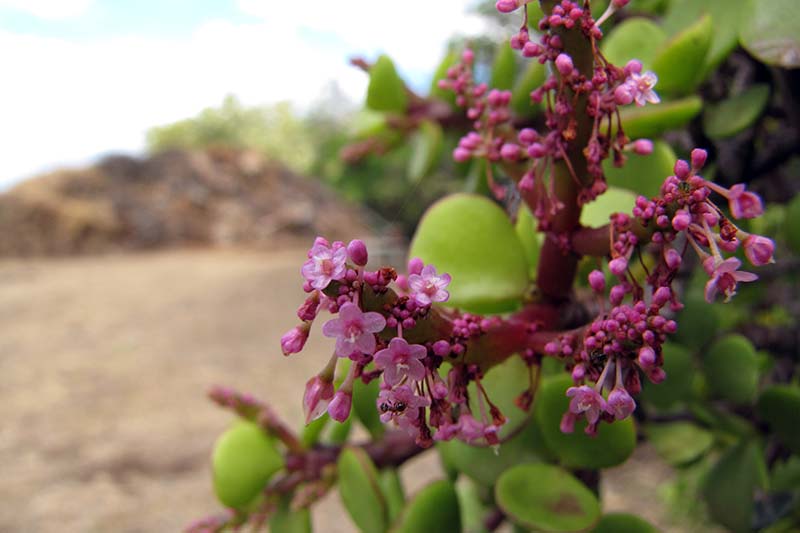
Although this species (Portulacaria afra) is sometimes referred to as “dwarf jade,” “miniature jade,” or “small leaf jade,” it is unrelated to the jade plant, Crassula ovata.
In the wild, spekboom grows to be a large shrub or small tree, reaching 15 feet tall or more. But as a houseplant, it is easily kept at a smaller size with pruning, and can even be cultivated as bonsai.
Cultivation and History
Spekboom is native to dry areas of eastern and southern Africa, and is found specifically within Eswatini, Kenya, Mozambique, and South Africa. It has also naturalized on the Italian island of Sicily.

In its native range this species grows in scrubland and thickets, and is found in various habitats including dry flatlands, dry river valleys, and north-facing rocky slopes. It can also grow in small crevices on cliff faces.
If you’ve been wondering why this plant is called “elephant bush,” – well, it’s named after one of its biggest fans, and I mean that quite literally. Elephants and other African wildlife like black rhinos, use the plant as forage.
It’s also sometimes called “elephant food” or “elephant plant.”
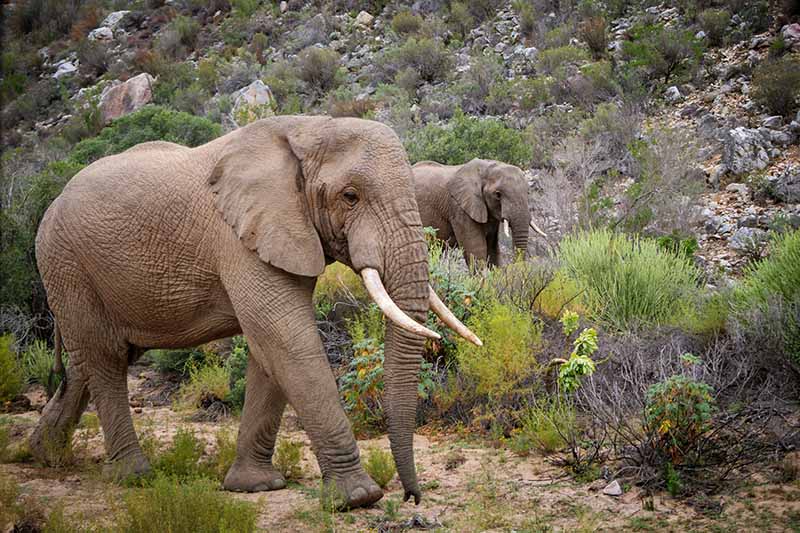
Also known as “purslane tree,” P. afra is classified botanically as a member of the Portulacaria genus.
Portulacaria – sounds sort of familiar, right?
The genus name Portulacaria means “like portulaca,” more or less, while the specific epithet “afra” means “from Africa.”
This genus was previously classified as part of the Portulacaceae family, which includes plants like moss rose (Portulaca grandiflora) and purslane, whose leaves bear a strong resemblance to those of elephant bush.
However, botanists later determined that the Portulacaria genus needed to be reclassified to a different plant family, Didiereaceae, which is more closely related to the cactus family, Cactaceae.
Spekboom is a plant with many different common names, as outlined above, and even botanists have had multiple ideas about what the species should be called – P. portulacaria, Haenkea crassifolia, and Crassula arborea are all considered synonyms.

Including the subject of our article, many of the members of the Portulacaria genus are also commonly referred to as “porkbush.” And its common name “spekboom” means “bacon tree” in Afrikaans.
With that thought in mind, it might delight you to know that this species is not only nontoxic, it’s edible!
Are you thinking that your wish, “if only bacon grew on trees,” has finally come true?
I’m going to have to burst your bubble – the leaves of this tree reportedly taste more like Granny Smith apples than smoked pork belly.
As with edible flowers and edible weeds, just because spekboom is technically edible doesn’t necessarily mean you should go hog wild and pig out on handfuls of porkbush leaves!
To start with, houseplants are sometimes sprayed with various pesticides or fungicides, and since these plants are not intended for use as food in the US or cultivated as such, chemicals and other products sprayed on them may be more potent and potentially toxic than those sprayed on your supermarket produce.
So, unless you know exactly what has been applied to your spekboom, it may be safer to refrain entirely from sampling this delicacy.
In addition to concerns about exposure to unhealthy chemicals, any new food not commonly included in your diet should be sampled in small amounts, and with caution. Just because something is considered “edible” doesn’t make chowing down on it appropriate for all individuals.
If you just can’t resist taking a nibble, be sure to correctly identify this plant since lookalikes from the Crassula genus like jade plant (C. ovata) are toxic.
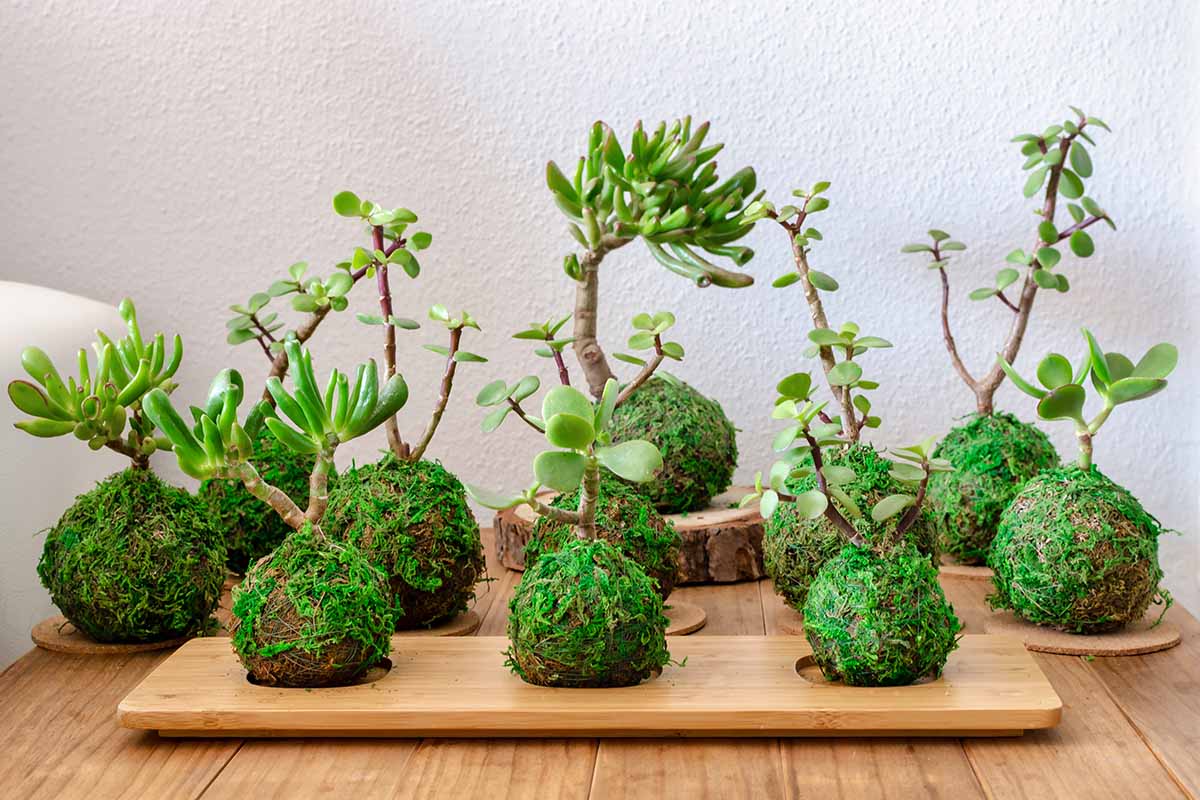
Wondering how you can tell jade and elephant bush apart?
The leaves of jade are thicker, and more elongated than those of elephant bush.
Elephant bush leaves are slightly indented as well, and tend to be much smaller than jade leaves.
Also, new stem growth on jade plants is green while that of elephant bush is red, pink, or purple.
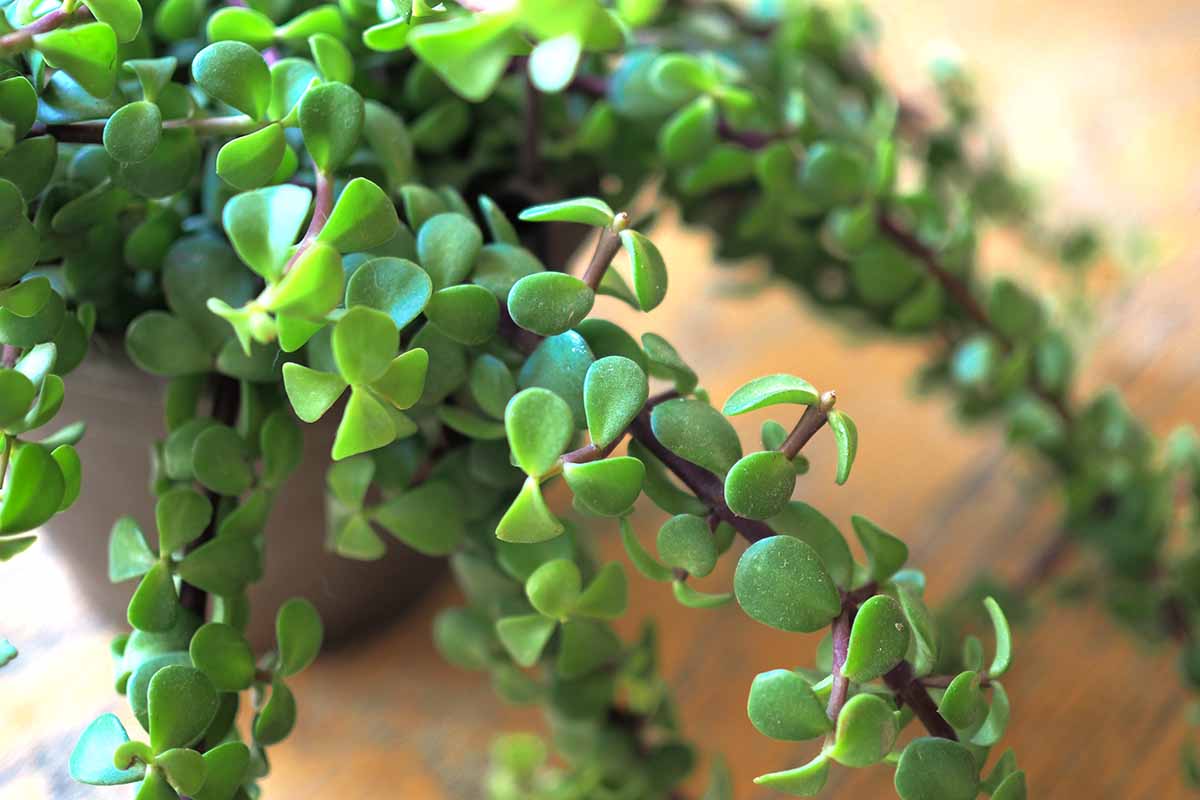
P. afra is often treated like a potential foodstuff and cultivated or foraged by individuals living in its native range, where it’s sometimes added to salads, soups, or stews.
It has also been used medicinally to treat skin issues, colds, inflammation, high blood pressure, and heat stroke, among many other ailments.
In addition to its varied medicinal uses, spekboom also excels at sequestering carbon, making it an important species when used in landscape restoration.
Spekboom can be grown outdoors year-round in USDA Hardiness Zones 9 to 11 or cultivated indoors in all regions. In this guide, we’ll focus on indoor cultivation as a houseplant.
Propagation
While spekboom can be grown from seed, since this species flowers infrequently, seeds are hard to source. No worries, though – it’s supremely easy to propagate this succulent from cuttings.
From Cuttings
The best time to undertake this project is in spring or summer when your spekboom is in an active period of growth.
Here’s what you’ll need: a mature porkbush, scissors or gardening pruners, potting medium, and four-inch nursery pots. You won’t need rooting hormone for this project, since the cuttings root easily.
Sterilize the scissors by wiping them down with rubbing alcohol or hydrogen peroxide to avoid spreading pathogens.
Then take stem cuttings that are three to five inches long, cutting just under a leaf node. Depending on your purposes, you may want to take just one cutting, or several.

For spekbooms with a weeping form, I recommend taking several cuttings to create a full hanging basket. For those interested in creating bonsai, just one per pot will be enough.
After taking the cuttings, let them callus over in a cool, dry location for two days.
Fill your nursery pots with potting medium, leaving an inch of room between the top of the soil and the rim of the pot – this will prevent soil from falling out during watering later.
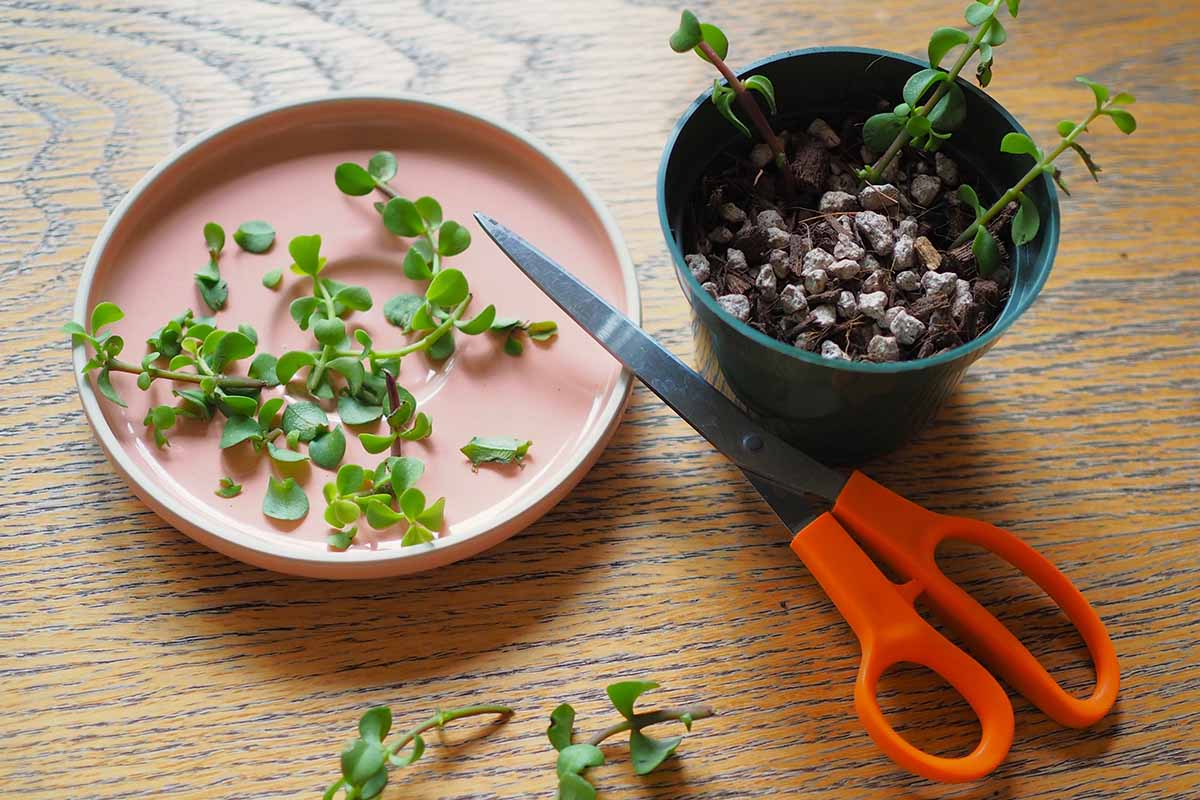
Cut off the leaves from the bottom inch or so of each cutting. Then stick the cuttings into the prepared nursery pots, spacing them about an inch or so apart for a houseplant with a full appearance, or centering single cuttings in the middle of the pots.
Water in the newly potted cuttings and then place them in indirect, bright light to take root.
It may take four to six weeks for the cuttings to root. Water these specimens whenever their potting medium has thoroughly dried out.
You can learn more about propagating succulents in our article.
How to Grow
Elephant bushes are easy to care for, but it’s a good idea to learn what conditions they prefer so you don’t accidentally kill them with too much kindness.
Sun
Outdoors, elephant bush will thrive in full sun to part shade. For houseplants that translates into direct sunlight, or indirect bright light.
You might find a spot with the right amount of light close to a south- or west-facing window, or several feet away from such windows.

However, before placing a new plant in direct sunlight, give it a gentle transition to acclimate first, gradually increasing its exposure to direct sun.
If plants aren’t getting enough light, their stems will become stretched out, with bigger gaps between leaves, a phenomenon known as “etiolation.”
Relocating such specimens to locations with more light will help plants remain more compact. Available sunlight can also be supplemented with an electric grow light.
Water
Hailing from arid regions, elephant bush is a drought-tolerant plant. When it comes to watering, keep in mind that you are more at risk of hurting yours by overwatering than by underwatering it.
However, although this succulent can withstand some neglect, it will grow into a more luscious houseplant with regular waterings.
In general, allow the plant’s potting medium to dry out thoroughly in between waterings, then water deeply.
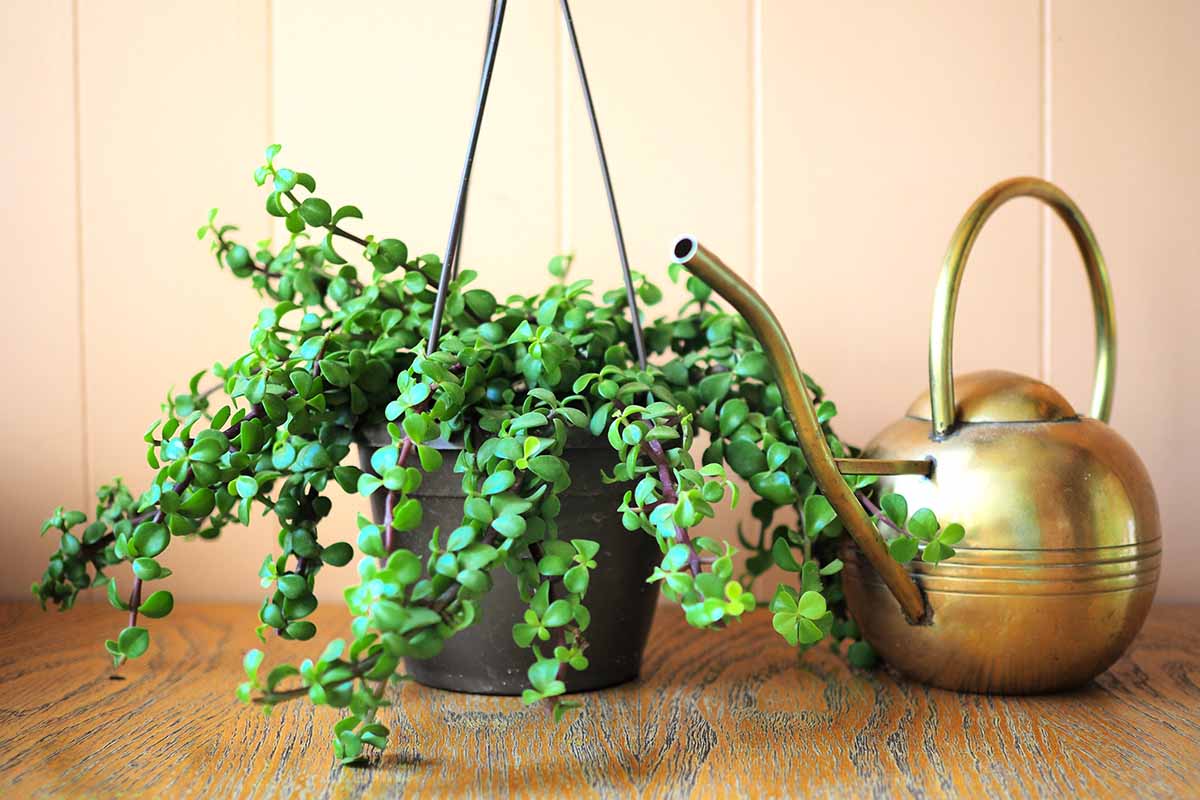
Since foliage can become quite dense in pots, it can be helpful to use a houseplant-adapted watering can for this task.
Also, it’s best to avoid watering on overcast days.
And speaking of cooler weather, since P. afra is adapted to dry winters, most sources advise not watering these plants at all during the winter. However, this advice might be most appropriate for gardeners growing this succulent outside.
If your potted porkbush is inside during the winter in a warm, bright location, you may not want to withhold water entirely, but reduce frequency to account for shorter day lengths.
For those whose specimens are exposed to cooler winter conditions in the ground or outside on a patio in appropriate growing zones, it may be appropriate to withhold water until springtime.
Susan Mahr, state coordinator for the Master Gardener Program in Wisconsin writing for the University of Wisconsin-Madison Agricultural Extension, recommends looking for shriveling leaves as a sign that it’s time to resume watering.
And if you’re hoping to see flowers on your specimen, in addition to providing adequate light exposure, be mindful that this plant is more likely to bloom when watering is less frequent.
Soil
With a fairly wide native range, P. afra is quite flexible in its soil preferences, and tolerates moderately acidic to slightly alkaline soils with a pH of 5.6 to 7.8.
However, well-draining soil is a must.
A potting medium designed for cacti and succulents makes a perfect choice, such as Sun Gro Black Gold Cactus Mix.
This medium contains humus, perlite, pumice, and sand, and is available for purchase in eight-quart bags from Sun Gro Horticulture via Amazon.
Find tips on blending you own succulent soil mix here.
Temperature
Spekboom will thrive in the temperature ranges commonly found in climate-controlled households.
In its native range it is quite tolerant of dry conditions, so compared to tropical houseplants that crave humidity, you will not need to take steps to increase the humidity around your plants.
For those houseplant enthusiasts such as myself who live without air conditioning, dwarf jade is also tolerant of high heat and can handle temperatures of 100°F and above.
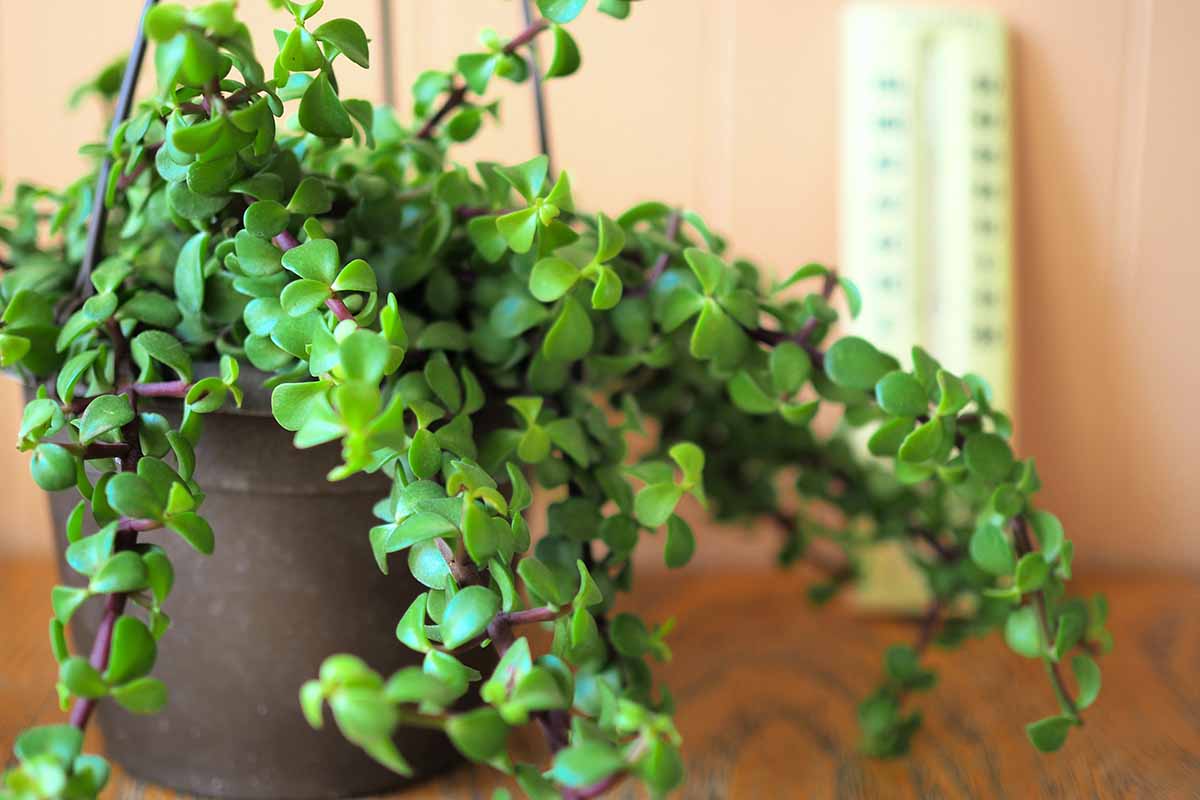
However, this succulent is sensitive to cold and frost, with younger plants being more vulnerable to cold temperatures.
While in some outdoor locations this species survives frost and hard freezes down to 25°F, avoid exposure to sub-freezing temperatures if tending plants outdoors to keep your spekboom looking its best.
Also, sudden temperature fluctuations such as those caused by drafty windows or doors, or locations near heat vents, can cause leaves to drop, so be sure to situate them away from cold drafts or hot spots.
Growing Tips
- Situate in bright indirect light, or direct sunlight.
- Allow the soil to dry out between waterings.
- Grow in a well-draining potting medium designed for succulents and cacti.
Maintenance
Elephant bush is a truly low-maintenance plant. Here’s what you’ll need to know to keep your plant looking tip-top over the long term:
Pruning
You’ll only need to prune your porkbush if you want to alter its shape or keep it to a more compact size.
Make sure to use sterilized scissors or garden pruners for this task to avoid spreading disease pathogens.

And keep in mind that any trimmings you take can be propagated – providing you with more specimens for your collection or to offer as gifts!
For tips on cultivating your spekboom as bonsai, check out our article which offers a complete introduction to bonsai.
Repotting
Spekboom should be repotted when it becomes rootbound, which will occur approximately every two years in healthy potted specimens.
It’s best to plan this project for the spring when the plant is starting to put on some new growth.
When repotting, choose a pot that is just one size larger than the current container. Oversized pots can prevent the growing medium from drying in a timely manner, and lead to root rot.
Also, make sure the pot has drainage holes to keep the growing medium draining well.

When you’re ready to complete this task, you’ll need an appropriate growing medium as described above. Place a shallow layer of fresh potting medium in the bottom of the new pot.
If the specimen is in a hanging basket, remove the hanger to make the transfer easier.
Next, tip the spekboom sideways and squeeze the pot slightly (if possible) to help ease the plant out – avoid pulling on foliage, which can break off easily. Any branches that are broken off during this process can be rooted to start new plants as described in the propagation section above.
Once the porkbush is released from its pot, rub the flat of your palm along its root ball to help loosen it and make its transition easier.
Place the spekboom into its new pot, adding or removing growing medium so the top of the root ball is about one inch below the rim of the pot.
Now comes the hard part – despite every good gardener’s natural inclination to water the plant after this operation, wait a week instead, then return to your normal watering routine.
Fertilizing
Spekboom is adapted to poor soils and does not require fertilization.
However, if you’d like to encourage growth, use a gentle fertilizer intended for use on succulents, such as Dr. Earth’s Succulence Cactus and Succulent Food, which has a 1-1-2 NPK ratio.
Dr. Earth’s Succulence Cactus and Succulent Food
You can find Dr. Earth’s Succulence Cactus and Succulent Food available for purchase from Arbico Organics.
Follow the manufacturer’s instructions for applying this product.
Want to learn more about plant nutrients? Be sure to read our article on what plants need and when they need it.
Where to Buy
With emerald-green leaves, the species plant P. afra has an upright, sprawling growth habit.
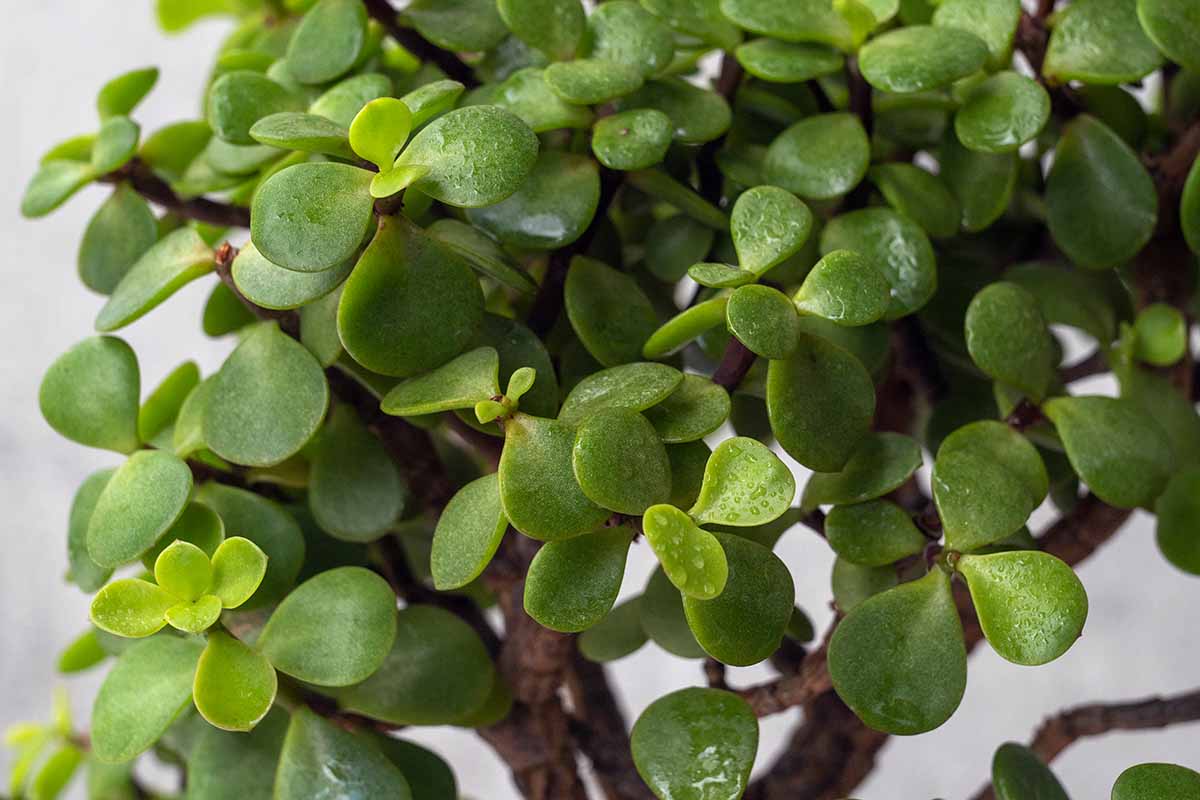
Stems are reddish brown, maturing to gray, and are covered with half-inch-long leaves.
P. afra can grow to be a small shrub or tree when grown in the landscape, but as a houseplant it can be pruned to keep it at a manageable size – there’s no need to let it get as big as a pachyderm.

You can purchase a P. afra specimen in a four-inch nursery pot from Hirt’s Garden Store via Amazon.
When you’re looking to purchase an elephant bush, you’ll have the option to choose between several different cultivars in addition to the straight species.
And among these you can also choose from specimens pruned into bonsai forms or those already placed in hanging baskets. Here are a few recommended selections:
Prostrata
Also known as “groundcover jade” or “dwarf elephant food,” ‘Prostrata’ is a creeping cultivar of this species.
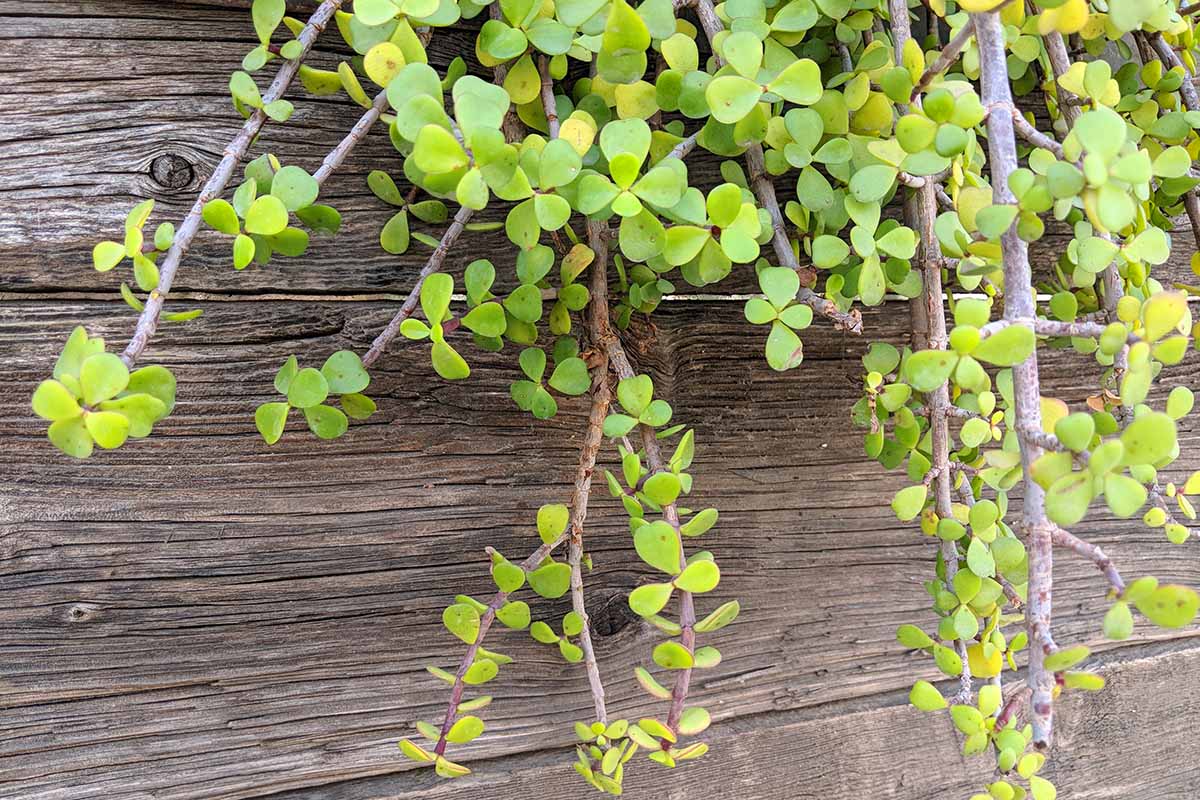
With emerald-green leaves on reddish-purple stems that mature to gray, this variety makes an excellent choice for a hanging basket, or for a ground cover in a succulent planter.
It’s also sometimes called P. afra ‘Minima.’
Interested in purchasing ‘Prostrata’ for your collection? You’ll find it in a six-inch hanging basket from Altman Plants via Walmart.
Variegata
‘Variegata’ is a variegated form of P. afra that has green leaves with cream-colored margins, sometimes edged in pink.
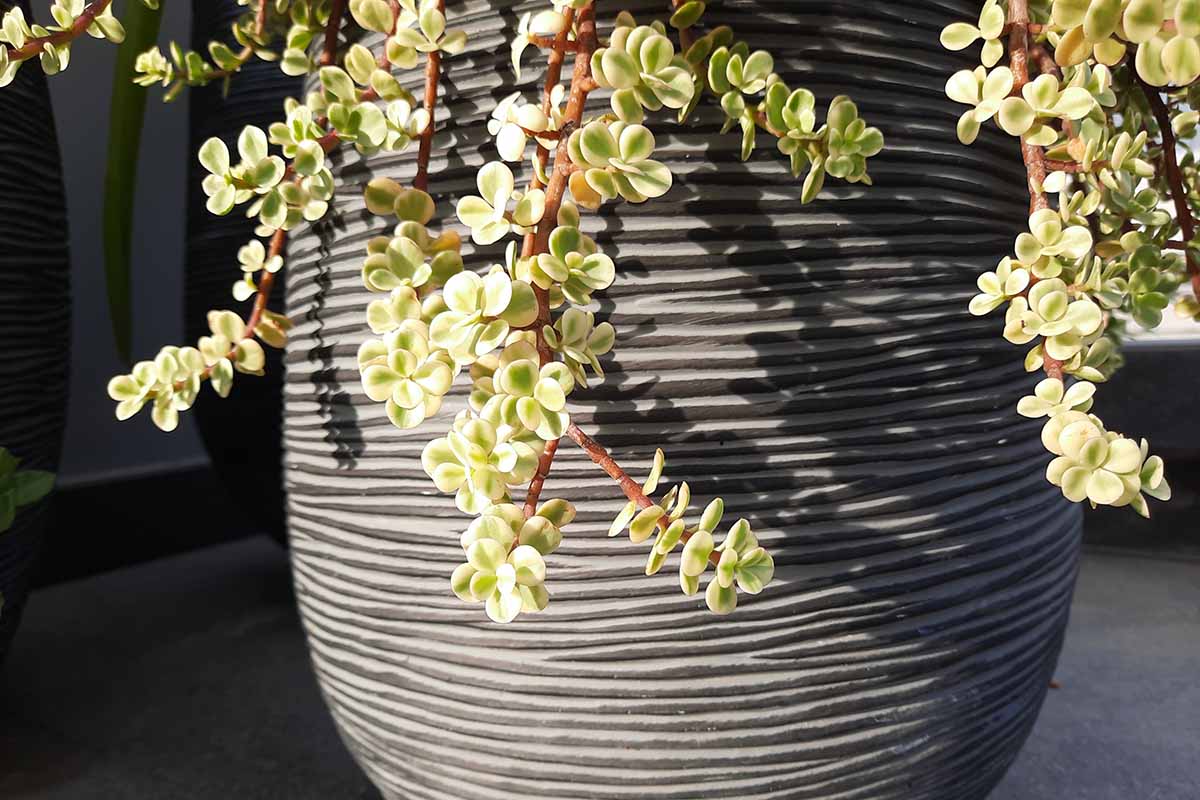
Also known as “rainbow bush,” new growth on this compact variety can be cream-colored or cream with pink margins.
Rainbow bush has slightly different care requirements than the species plant – it is slower growing and less tolerant of full sun.
P. afra ‘Variegata’ Bonsai Tree
If you’re interested in adding a bonsai specimen to your collection, you can purchase a fifteen-year-old, twelve- to thirteen-inch-tall variegated elephant bush from Bonnsai via Walmart.
Want More Options?
Discover more spekboom cultivars in our guide to 11 of the best types of elephant bush.
Managing Pests and Disease
Elephant bush is not particularly prone to disease or pest problems. However, weak specimens will be more likely to succumb to illness or infestation, so make sure to provide the right amount of water, drainage, and sunlight.
Herbivores
For a spekboom placed outside for the summer or grown outdoors year-round, any hungry four-legged herbivore or omnivore with access might enjoy nibbling its succulent leaves, with the prime culprits in North America being rabbits and deer.
This plant is particularly attractive as a dining option to animals during the summer months because of its water-storing, succulent leaves.
Get tips for deer-proofing your garden in our article.
Insects
It’s a good idea to give these plants the once-over when watering them, to inspect their foliage for signs of pests.
Be on the lookout for scale, spider mites, and mealybugs, all of which commonly plague houseplants. These can be controlled with nontoxic neem oil.
Read our articles to learn more about identifying and controlling mealybugs, spider mites, and scale insects.
Diseases
The disease you are most likely to encounter with elephant bush is root rot.
Specimens affected by this disease may have mushy stems. Plants may also wilt and exhibit brown foliage.
Root rot is easily prevented through proper watering and drainage. Make sure your pot is correctly sized and has drainage holes, ensure that the potting medium drains well, and avoid overwatering.
The only way to tell for sure whether a plant has been affected by root rot is to check the plant’s roots.
If you notice any rotten roots, trim them back so only healthy roots remain. Repot in a suitable potting medium, as discussed in the soil section above.
Best Uses
Just as it is a plant of many names, P. afra is a species with a multitude of potential uses.
Porkbush makes a great succulent houseplant for households with curious kids or mischievous pets, since it’s nontoxic and provides a safe alternative to jade plants.
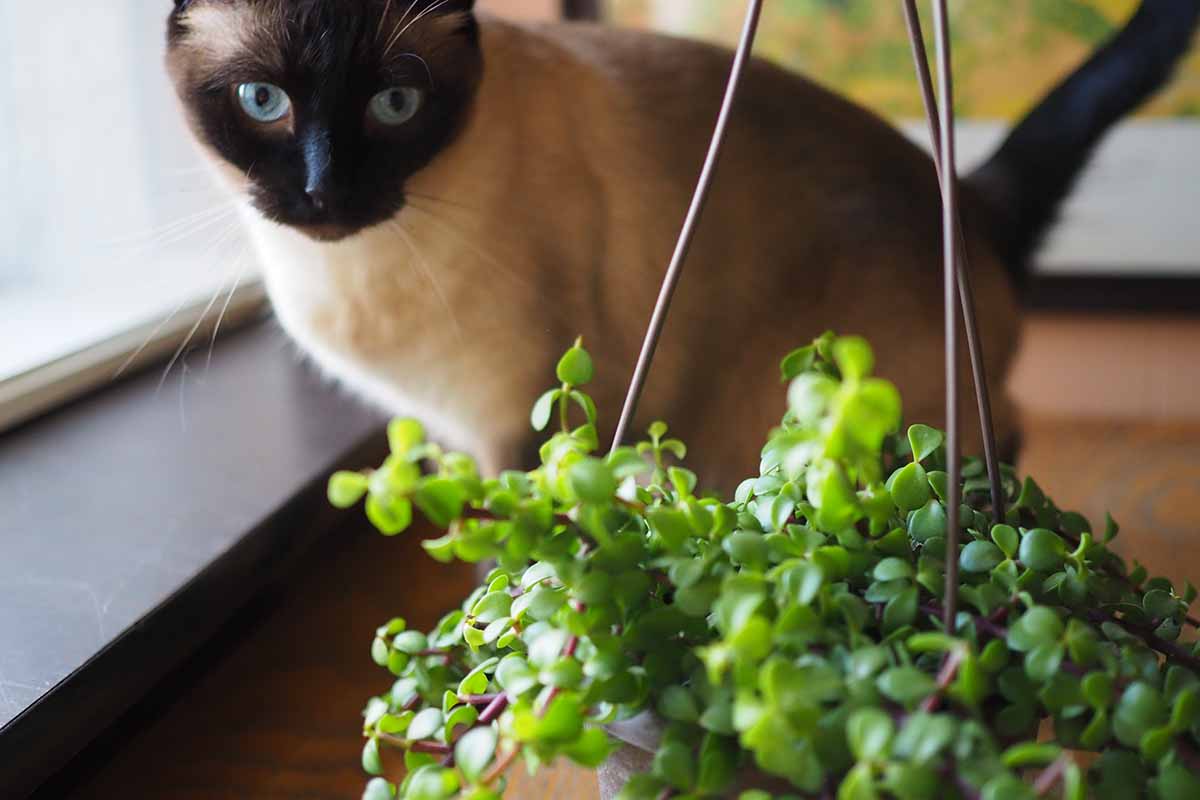
For indoor gardeners in search of options for hanging baskets, the trailing varieties of P. afra are excellent choices.
These low-growing cultivars can also be put to beautiful use as ground covers in succulent gardens or planters.
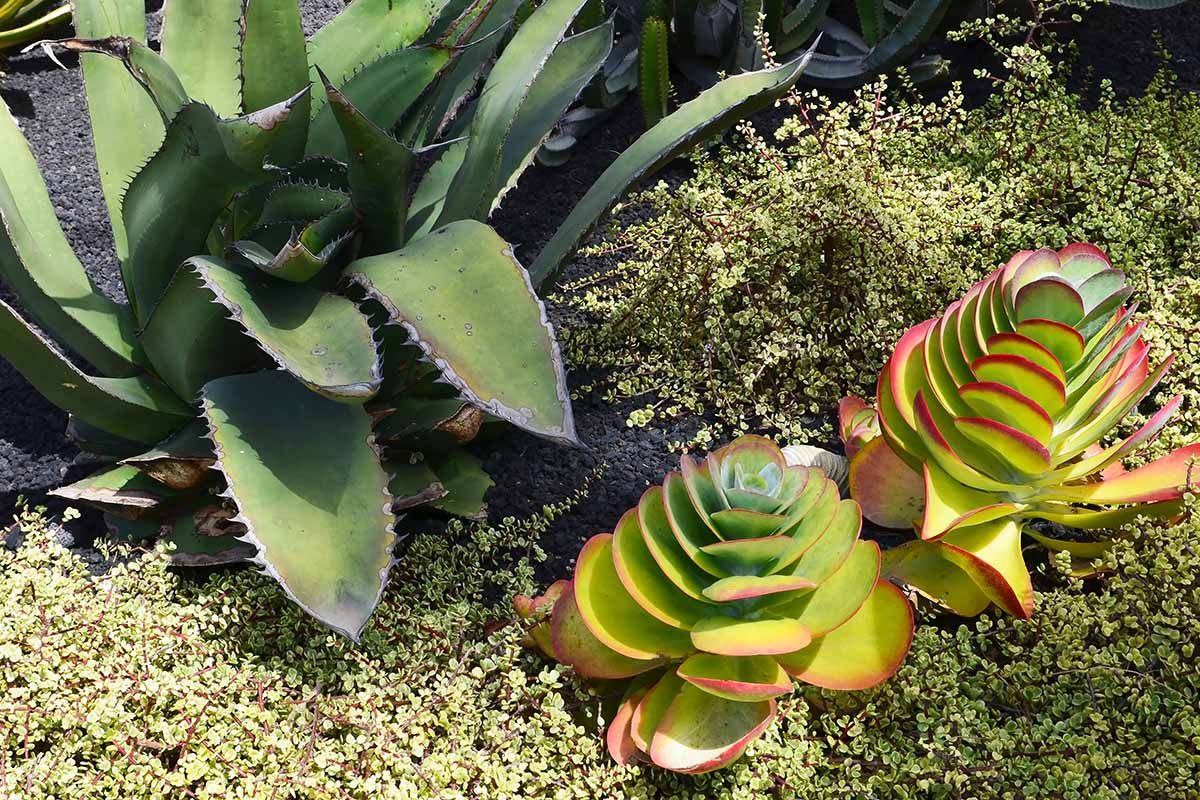
As for types of porkbush with upright growth habits, they can be pruned to take on bushy shapes, or tall upright forms, and they can be trained in many different styles of bonsai.

For those living in USDA Hardiness Zones 9 to 11, spekboom can be used in the landscape year-round provided it is given appropriate drainage and that it isn’t inundated with rain.
Outdoors, these large shrubs or small trees can be used as screens or hedges once they reach their mature height. They can also offer their services as evergreen firebreaks.
Finally, spekboom has been shown to excel at biological carbon sequestration as part of thicket restoration programs in South Africa over the course of two decades. That means it can take carbon dioxide out of the air and store it, helping to reduce greenhouse gasses in the atmosphere and fight climate change.
Quick Reference Growing Guide
| Plant Type: | Succulent | Flower / Foliage Color: | Lavender / green; cream and green; cream, green, and pink |
| Native to: | Eswatini, Kenya, Mozambique, and South Africa. | Maintenance | Low |
| Hardiness (USDA Zone): | 9-11 | Tolerance: | Drought, heat |
| Bloom Time: | Infrequent, late spring to early summer | Soil Type: | Cactus and succulent potting mix |
| Exposure: | Full sun to part shade | Soil pH: | 5.6-7.8 |
| Time to Maturity: | 10-20 years | Soil Drainage: | Well-draining |
| Planting Depth: | Top of root ball level with soil (plants) | Companion Planting: | Aloe, crown of thorns, grape ivy, hoya, jade plant, jewel leaf plant, peperomia, ponytail palm |
| Height: | 8-15 feet (outdoors) | Uses: | Bonsai, fire resistance, hanging baskets, hedges, screens |
| Spread: | 4-6 feet | Order: | Caryophyllales |
| Growth Rate: | Slow to moderate | Family: | Didiereaceae |
| Water Needs: | Low | Genus: | Portulacaria |
| Common Pests and Diseases: | Mealybugs, scale, spider mites, whiteflies; root rot | Species: | Afra |
Spekboom, a Spectacular Succulent
The many fine features of spekboom make it a spectacular choice as a succulent houseplant.
It requires little water, demands only minimal maintenance, can tolerate dry air, is safe to have around children or pets, and can even help to restore habitats and improve environmental conditions in its native range.
Spekboom is a dream houseplant for me, and I hope it is for you, too!
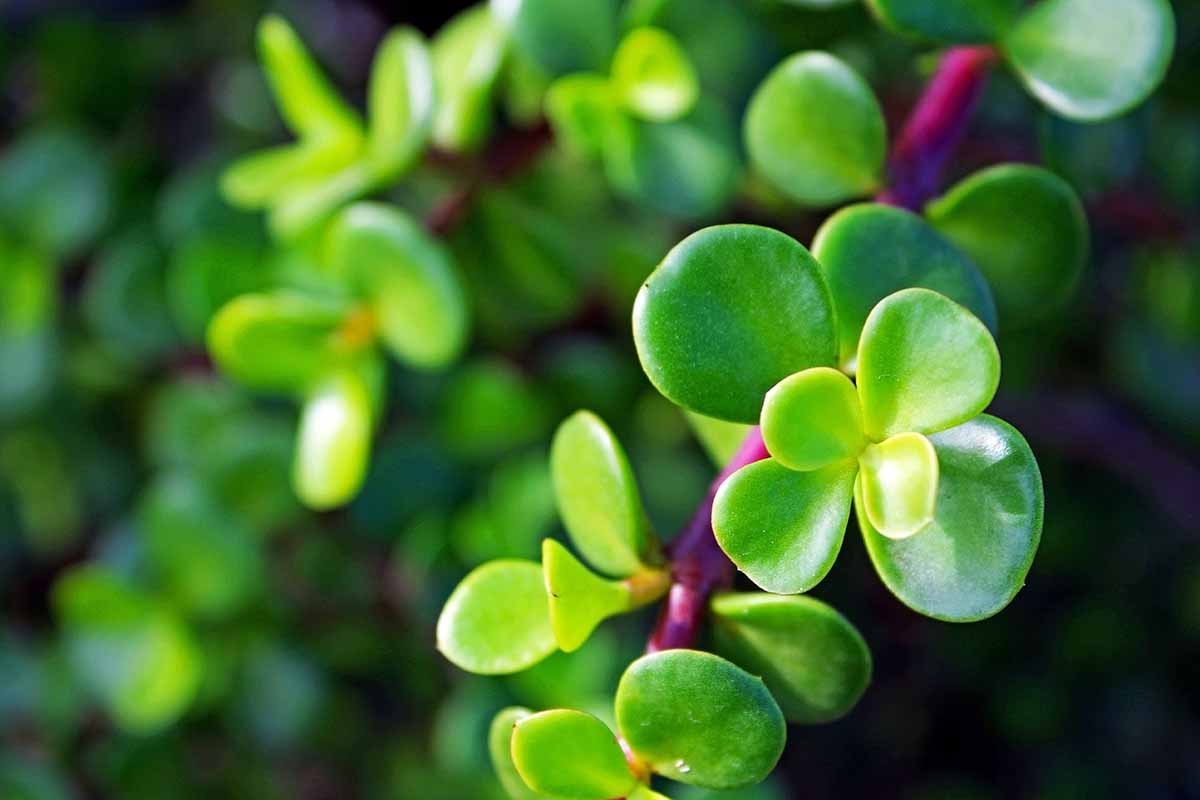
The next time someone tells you it’s time to talk about the elephant in the room, you can nod and wax poetic about your spectacular spekboom.
Are you growing spekboom as a houseplant? How did you first discover this botanical marvel? Tell us your elephant bush stories in the comments section below – and feel free to ask questions if you need help with your porkbush too!
Do cacti and succulents make your heart pitter-patter just like they do mine? If so, here’s some more recommended reading:



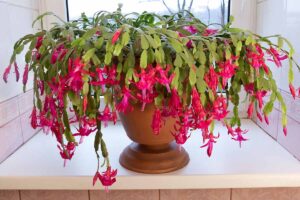
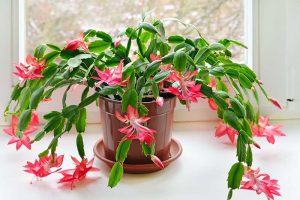
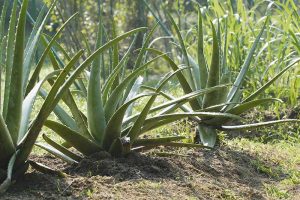
This is a lovely plant and easy to grow. Even EDIBLE!!
Thanks for this article, Kristina. I’ve just inherited my mum’s 45 year old Elephant Bush (I’ve always thought it was a jade bush!) that is somewhat neglected now. Your information is helpful in my mission to bring it back to its glory 😊
Hi Hannah,
Thanks for letting us know you found this article helpful. I’m glad we’re able to help you with caring for your plant – especially since it’s a precious heirloom. Best of luck and do let us know if we can be of any help!
I learned about this great plant while I was working as a floral designer here in Atlanta. I was always on the lookout for durable plants that my clients couldn’t kill too quickly. This was a good solution. I have one that’s about 2 1/2 feet tall that looks like a tree in a pot that I’ve had for about 10 or more years now. I bring it in every winter but inevitably all the leaves fall off of it. It recovers just fine. What am I doing wrong that I need to keep the leaves during the winter? I… Read more »
Hi David, It sounds like you are taking excellent care of your elephant bush to have had it for so long – congrats – and what a lucky plant! As to your question – it’s not unusual for these plants to lose leaves when being transitioned from living outdoors for the summer to living indoors for the winter. However, there are a couple of things you could try to prevent or minimize this. The first is to check that it’s getting enough light. What seems like bright light to our eyes might not actually be bright light for our plants.… Read more »